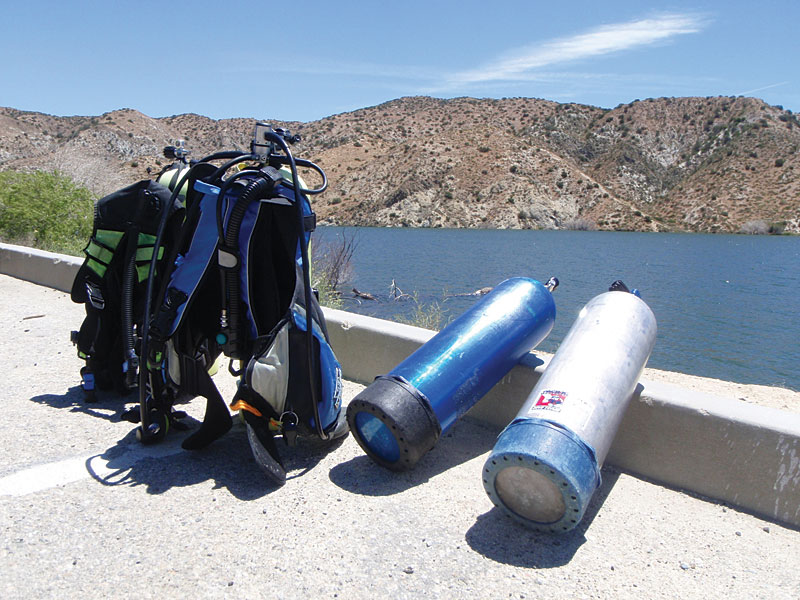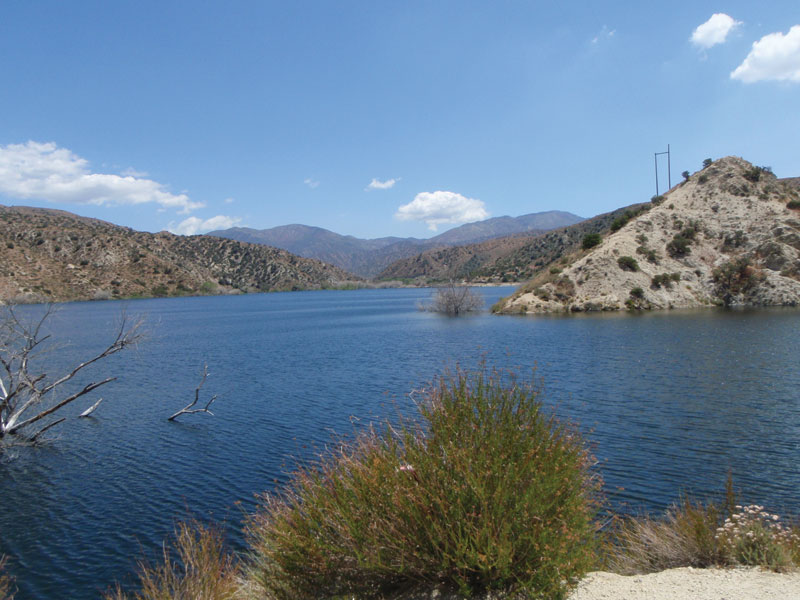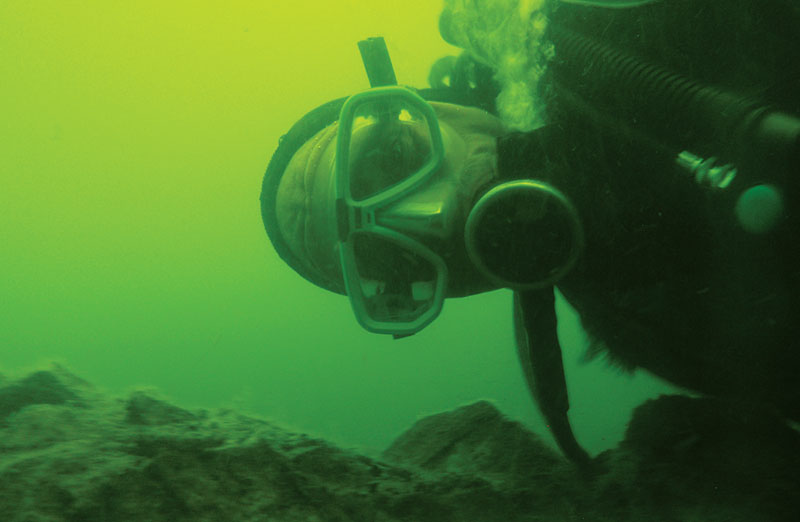Located in the Angeles National Forest, on the northern slopes of the San Gabriel Mountain Range in Los Angeles County, there is a historical construction project that has supported irrigation, surface water needs, and now a newly explored California dive site!
A look at its impressive history reveals that in the late 1880’s, local water districts were formed and began working together to distribute the water of Littlerock Creek. 87 years ago, in 1924, the Littlerock Dam was completed. It was considered the highest multiple-arch dam in the world: 190ft high, a crest length of 720ft, and a capacity of 4,200 acre-feet of water. (An unexposed portion of the 190ft is keyed deep in granite.)
Story and Photos by Brian Wright, Hardcore Dive Team
Sometime in the 1930’s, it was given upgrades to be compatible with earthquake specifications, as it is located 1.5 miles south of the San Andreas Fault. The large, recent retrofit was completed in June, 1995 by a shotcrete process, adding 4 inches of a roller-compacted steel-fiber concrete face to the upstream side of the 28 arch barrels, and capping the dam’s overall spillway elevations by raising it 12 feet, nearly doubling its capacity to now hold approximately 1.1 billion gallons of freshwater diving!
There had been considerable speculation in the local diving community about the site’s potential dive quality for many years. An ambitious, adventurous dive group known as the HardcoreDiveTeam took the initiative and put itself in a position to explore, with an extensive voluntary research plan of diving to answer such questions, and to reveal the mysteries surrounding the surface and below! What we found, although not completely opposite of what was expected, continues to surprise us with new discoveries on every dive.
For the past 2 or 3 years, the water level has remained full, giving the reservoir an elevation of just over 3,000ft. In November 2010, our first dives were in the coves. Going to 25ft deep, the surface layer of water was 50 degrees, with 10-12ft visibility! Since we were diving in the afternoon, the sun had already gone over the hills. Just a light green tint of algae, much like spring blooms in the Pacific, were found, along with goldfish carp the size of garibaldi. After an hour of traveling cautiously in 7mm wetsuits, Jeff and I were chilled to the bone. We did get a reading of 38-40 degrees below 25ft, and that’s one of the things we wanted to know. As we were getting out of our gear, a car came around the corner, a guy got out, and as if he knew us, said, “Hey, how are you? How’s the diving?” We introduced ourselves. His name, it turned out, was Rick Cooper, and he’s the guy who’s running the Littlerock Dam Reservoir. Right away he was offering large group reservations for up to 40-50 divers for all weekend long, with boat access to all points in the lake, treasure hunts, and private reservations for parties of 50!
The next few months packed heavy rain and snowfall in the San Gabriel Mountains, and unleashed a fury of energy heading for the spillway! During that time the diving was great, as icy, crystal clear snow waters filled the lake, while the narrowing surface layer was getting thinner and going over. We started diving the monstrous structure of the dam itself, and the back, or east, side of the lake, where solid granite vertical walls stretch long enough to explore up to an hour at a good pace. Dropping into the darkness with overhangs, crossing granite ridges that look as sharp as if they’d been chiseled, laced with trees to hold schools of large mouth (black) bass, finding and following underwater canyons surrounded by 40ft sheer vertical walls. We were both thinking the same thing, “oh yeah!” Such good dives led us on future dives to go deep and find the bottom. Our descent point was the back wall close to the dam. We started descending fast. Going through 20ft of warm green water, we plunged right in to find temps in the low 40s; icy crystal clear water, yet darker than graphite! In a way, the diving was like caving, we lost all signs of the surface. At 70ft, the bottom had a 3” silt layer covering sandy, rocky granite. Huge trees, on their sides, appeared out of nowhere, resembling skeletons of the past. Total black-outs could occur in mere seconds by stirring up sediments. With careful preparation and training, the objectives go on and on!
Diving near the stream inlet is shallow and flat. Sunken campsites can be found at 10 to 20ft deep, along with concrete picnic tables and National Forest signs for “no off-roading!” This dive site can provide nearly all aspects of training: advanced, altitude, deep, night assimilation, navigation, dry suit, boat, etc. Drift and ice diving are about the only two specialties that would be hard to teach here. The nearest full support dive shop for air fills, rentals, etc. is Sport Chalet Palmdale, about 15 miles away.
Some of the fish species we observed were: largemouth bass, goldfish carp, and soon to come Department of Fish and Game (DFG) trout plants. Note: Largemouth will swim right up to you and stop, much like his black sea bass friend. Spearfishing is DFG prohibited, and they actively patrol.
Directions: coming from Los Angeles, take the 14 Freeway north to Pearblossom Highway, take Pearblossom east, then make a right on Hwy 138. Follow 138 for a couple hundred feet, and turn right again at Cheseboro Road (heading straight for the San Gabriels). Go 3 miles to the guard shack. Access is open from 7am to 7pm, with an entry fee of $5.00 per car, $2.00 per passenger. Children under 12 are free. Follow the road up around the dam, and from the roadside all water access is within a few feet of parking.
Call ahead for water level details, and ask for Rick Cooper at 661-533-1923. If the water is being drawn by the gate in a controlled flume, as it does in the summer time, put some distance between you and the dam structure, especially near the bottom. Diving from north to south is a safe direction away from the dam. If you want someone to go with you, contact brian@hardcorediveteam.com
HardcoreDiveTeam divers involved in bringing this information to interested and adventurous California Divers are: Jeff Wright, Frank Lewis, Kenneth White, Renee Williams and myself. We ask each other “Hey, what’d ya think?” and answer, “Awesome! “Want to do it again?” “OH YEAH!”
Story and Photos by Brian Wright, Hardcore Dive Team
.



